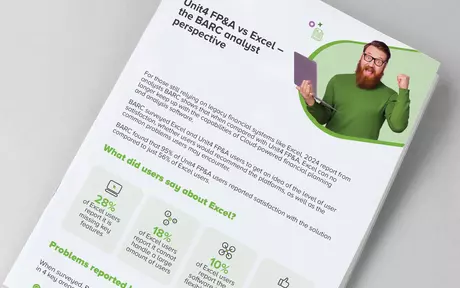Simplifying EU Taxonomy reporting with Unit4 FP&A
For organizations striving to meet environmental and regulatory standards, EU Taxonomy reporting represents a critical step towards greater sustainability and transparency. However, for those relying on outdated legacy systems such as siloed excel spreadsheets, achieving compliance is far from straightforward.

These legacy systems often lack the flexibility, automation, and granularity needed to handle the complexities of taxonomy reporting, leaving organizations overwhelmed by manual processes and fragmented data.
In addition to ESG compliance demands, EU Taxonomy reporting adds another layer of complexity that demands digital maturity to cope.
This is where Unit4 Financial Planning & Analysis (FP&A) can bridge the gap, as a reporting tool. Our platform transforms the daunting task of EU Taxonomy reporting into a streamlined, efficient process, with a single source of the truth.
Keep reading:

Explore the power of FP&A in minutes
Watch short demos that match your Financial Planning & Analysis priorities – whenever it fits into your schedule.
What is EU Taxonomy Reporting?
EU Taxonomy reporting is a wider ESG framework developed by the European Union to classify sustainable economic activities. The EU Taxonomy is also linked to the Corporate Sustainability Reporting Directive (CSRD), which mandates sustainability reporting for certain companies.
The primary goal is to guide organizations, investors, and policymakers in aligning with sustainability goals while fostering transparency in environmental and financial reporting.
EU Taxonomy establishes clear criteria for determining whether an activity contributes to environmental objectives, such as mitigating climate change, sustainable use of water, pollution prevention, or promoting circular economies, aligned with a net zero trajectory of 2025.
Why should organization’s pay attention?
Adhering to EU Taxonomy reporting is vital for organizations to demonstrate their commitment to sustainability by reporting on activities aligned to the EU’s objectives. It ensures compliance with regulatory requirements and enhances accountability.
Additionally, it helps attract eco-conscious investors by highlighting alignment with green initiatives. This remains true for customers as well, who may have interest in an organization’s sustainable practices.
However, achieving accurate and efficient reporting can be challenging without the right tools, especially for those relying on outdated systems.
Why should organization’s pay attention?
Adhering to EU Taxonomy reporting is vital for organizations to demonstrate their commitment to sustainability by reporting on activities aligned to the EU’s objectives. It ensures compliance with regulatory requirements and enhances accountability.
Additionally, it helps attract eco-conscious investors by highlighting alignment with green initiatives. This remains true for customers as well, who may have interest in an organization’s sustainable practices.
However, achieving accurate and efficient reporting can be challenging without the right tools, especially for those relying on outdated systems.
How is EU Taxonomy reporting changing?
Key changes include raising the reporting threshold to companies with over 1,000 employees and €450 million in turnover, introducing materiality thresholds to exempt minor activities, and reducing mandatory data points by 66% for streamlined reporting.
Additionally, the "Do No Significant Harm" criteria have been clarified to eliminate ambiguities, particularly around chemical use and pollution prevention. These adjustments make compliance more practical and cost-effective while maintaining transparency and alignment with sustainability goals.
66%
less mandatory data points
Why legacy systems will struggle with EU Taxonomy reporting
The taxonomy is challenging, for example, in February 2025, the EU platform for sustainable finance published a report with recommendations on how it could be simplified.
Organizations using legacy systems face a range of obstacles when attempting EU Taxonomy compliance, including:
-
Fragmented data: Legacy systems often store financial and operational data across disparate silos, making it difficult to identify which activities align with sustainability metrics.
-
Manual processes: Legacy systems lack automation, relying heavily on manual data entry and calculations, increasing the risk of human error and unmanageable workloads.
-
Time-consuming reporting: Without automated tools, extracting, processing, and aligning data for compliance requires significant time and effort.
These challenges not only increase operational inefficiencies but also put compliance accuracy and deadlines at risk.
How Unit4 FP&A simplifies EU Taxonomy reporting
Unit4 FP&A provides a solution designed with automation, integration, and compliance in mind. Legacy systems no longer need to hold your organization back.
With Unit4 FP&A’s advanced tools for data integration, compliance tracking, and reporting dashboards, you can take the complexity out of EU Taxonomy reporting while enhancing transparency and efficiency.
By simplifying and enhancing EU Taxonomy reporting, Unit4 FP&A not only accelerates compliance but also enables organizations to focus on their broader sustainability goals – here’s how:
Streamlined data integration
Unit4 FP&A integrates financial and non-financial data directly from your systems, including ERP platforms, cost centers, and accounts. This eliminates the data silos common in legacy systems. Whether it’s importing data or accessing it natively from FP&A systems, the platform ensures increased accuracy when an organization is required to report on their taxonomy-eligible and aligned activities.
Automation for greater efficiency
Automation lies at the core of Unit4 FP&A’s capabilities. Non-taxonomy-eligible values can be filtered out automatically, while taxonomy-eligible activities are specified with precision. This automates the identification of compliance-ready data, removes repetitive tasks, and significantly reduces the risk of human error.
Dynamic compliance tracking
Unit4 FP&A allows you to assign compliance percentages to cost centers and accounts. For example, you can mark 80% of a cost center as non-aligned, leaving only the relevant 20% for EU Taxonomy reporting. Manual overrides are also supported, making it easy to refine and ensure data accuracy when needed.
Enhanced reporting with dashboards
The system’s intuitive dashboards provide real-time oversight into compliance. Users can track data that is taxonomy non-eligible, eligible but non-aligned, or fully aligned. This level of visibility simplifies decision-making and allows organizations to easily meet reporting deadlines.
To learn more about Unit4 FP&A’s capabilities for managing EU Taxonomy reporting, visit our website, talk to sales, or watch our demo.








